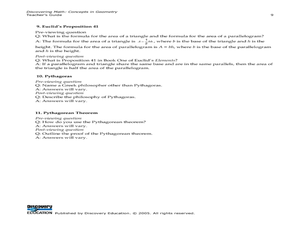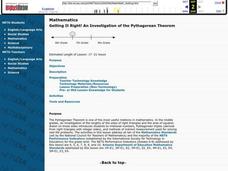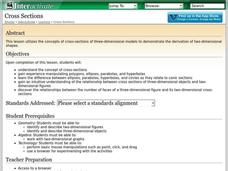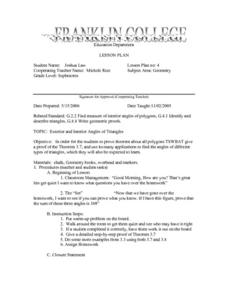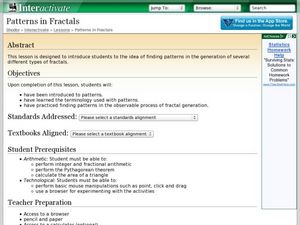Curated OER
Discovering Math: Concepts in Geometry
Middle and high schoolers explore the concept of proving the Pythagorean Theorem. They research proofs of the Pythagorean Theorem. Pupils create posters of proofs, and research Greek mathematicians.
Curated OER
Tessellations: Geometry and Symmetry
Young scholars explore the concept of tessellations. In this tessellations lesson, students use an applet to construct tessellations. Young scholars use regular polygons to construct tessellations. Students find patterns and symmetry in...
EngageNY
Proving the Area of a Disk
Using a similar process from the first lesson in the series of finding area approximations, a measurement resource develops the proof of the area of a circle. The problem set contains a derivation of the proof of the circumference formula.
EngageNY
How Do Dilations Map Segments?
Do you view proofs as an essential geometric skill? The resource builds on an understanding of dilations by proving the Dilation Theorem of Segments. Pupils learn to question and verify rather than make assumptions.
Illustrative Mathematics
Equal Area Triangles on the Same Base II
A deceptively simple question setup leads to a number of attack methods and a surprisingly sophisticated solution set in this open-ended problem. Young geometers of different strengths can go about defining the solutions graphically,...
Curated OER
Getting It Right! An Investigation of the Pythagorean Theorem
Learners construct a variety of right triangles using a right-angled set square, cutting corners from pieces of paper or cardboard, and using dynamic geometry software. They measure the sides of these various right triangles and record...
Curated OER
The Truth About Triangles And Proofs
Learners engage in a lesson that is about the classification of triangles and the mathematical proofs involved in working with them. They work on a variety of problems that are created by the teacher with the focus upon the importance of...
Pennsylvania Department of Education
Creating Polygons
Students describe, make and compare polygons. In this creating polygons instructional activity, students identify properties of quadrilaterals and describe common features of two dimensional shapes.
Curated OER
Polygons All Around Us!
Students explore the concept of polygon properties. In this polygon properties lesson, students draw polygons with different numbers of sides such as pentagons, octagons, hexagons, etc. Students identify different geometric shapes in the...
Curated OER
Right Triangles
Learners classify triangles and make connections regarding angle measurements and attributes of acute, right, and obtuse triangles. They listen to teacher define and explain triangles. Everyone imagines a place where a broken wing for a...
Shodor Education Foundation
Cross Sections
Use this activity on cross-sections of three-dimensional shapes in your math class to work on algebra or geometry Common Core standards. The lesson includes a list of relevent terminology, and a step-by-step process to illustrate the...
Curated OER
Pythagorean Theorem by Graphic Manipulation
There are many different ways to show a proof of the Pythagorean Theorem. Here is a nice hands-on paper cutting activity that shows a graphic representation. You can even challenge your young Pythagoreans to come up with their own...
Curated OER
Investigating Area Using Tangrams
Tenth graders connect the history of geometry to problem solving. In this geometry lesson, 10th graders investigate polygons through hands on manipulatives and solve problems relating to parallelograms and triangles. They calculate the...
Curated OER
Regular Polyhedra
Tenth graders investigate the history of geometry and its different shapes. In this geometry lesson, 10th graders practice seeing three dimensional shapes and explain why there are only five polyhedra. They relate all the new materials...
Curated OER
Parallel and Perpendicular Lines
Tenth graders explore parallel and perpendicular lines. In this geometry lesson, 10th graders investigate the relationships associated with parallel lines and transversals, perpendicular lines, and the angles formed by these lines. ...
Virginia Department of Education
Circles in the Coordinate Plane
Make the connection between the distance formula and the equation of a circle. The teacher presents a lesson on how to use the distance formula to derive the equation of the circle. Pupils transform circles on the coordinate plane and...
Curated OER
Exterior and Interior Angles of Triangles
Tenth graders explore the exterior and interior angles of triangles. They use a theorem in order to prove a theorem about all polygons. Students use the theorem and its applications to find the angles of different types of triangles.
Curated OER
Pape's Theorems
In this math worksheet, learners find the length of the side of a regular hexagon whose area is numerically equal to its perimeter.
Curated OER
Patterns in Fractals
Learners explore the concept of fractal patterns. For this fractal pattern lesson, students use an applet about the Hilbert Curve to answer questions about rectangles and other polygons. Learners derive the fractal pattern when dividing...
Curated OER
Picking Pythagoras
Students discover that side measurement is used in determining angle classification of a triangle. By squaring sides, they predict whether triangles be right, obtuse, or acute. They prove the Pythagorean Theorem and use it to solve...


